July 2003
Collecting the US Bayonet, Model 1917
Many collectors pay little attention to the Model 1917 rifle and bayonet, feeling that it offers little in the way of collectible variations. Recently the Model 1917 Rifle has begun to attract more interest among collectors, probably partially due to the release of several by the CMP, and I have noted, more interest in the bayonets also. Since I have started getting more questions about them, I decided to discuss a few of the variations.
The Model 1917 is a US Rifle and Bayonet dictated by the necessities of war. England had been working on a rifle to replace the Lee-Enfield, and had adopted a totally new design in .276 caliber as the Pattern 1913. Production had not begun when they entered World War One in 1914, and the rifle was redesigned to chamber the then standard .303 cartridge then re-designated the Pattern 1914. It was evident that to switch production in any of the existing rifle plants to the new design would be impossible as it would interfere with production of the SMLE which was in critically short supply. The decision was made to contract production of the new rifle in the USA, and contracts were given to Remington, Winchester, and a new company formed as Remington Arms of Delaware (which produced the rifle at Eddystone, PA).
The bayonet retained the Pattern 1913 designation since it was not modified. To readily distinguish it from the very similar Pattern 1907, it was given two vertical grooves in the grips. The bayonets were produced in the US by Remington at their Bridgeport Works and by Winchester. Eddystone did not produce bayonets. Remington supplied about 1,243,000 bayonets and Winchester about 225,000 to the British.
By the time the US became involved in the war, the contracts were expiring. After the Ordnance Department looked at a number of options, it was decided to remodel the British Pattern 1914 rifle for the US .30-06 cartridge, and the rifle was designated United States Rifle, Caliber .30, Model of 1917. The P13 bayonet was adopted into US service as the Bayonet, Model 1917.

Click on the thumbnail for the full size photo.
The Model 1917 Bayonet As Illustrated in the Description and Rules for the Management of the United States Rifle, Caliber .30, Model of 1917
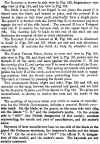
Click on the thumbnail for the full size photo.
The Description of the Model 1917 Bayonet From the Description and Rules for the Management of the United States Rifle, Caliber .30, Model of 1917
The Model 1917 Bayonet continued to be finished as the British version had been. According to British specifications, the finish was to be:
Blade: Hardened, Tempered, Polished and Sandblasted. Crosspiece (Guard): Browned
Pommel: Browned.
The remaining parts were Oil-Blackened.
Note: Both US and British terminology of the time used the term browning for what we now call bluing. Browning extended up the blade from the guard about 1 inch, covering most of the ricasso flats.

Click on the thumbnail for the full size photo.
A Remington Model 1917 Bayonet With British Marks Crossed
Out and US Added
Note the Double US Marking and the Lack of a Clearing Hole
Earliest deliveries by Remington were made from undelivered British production. These simply had the British proof markings crossed out and a US added. The orientation and location of the US mark varies greatly, and in some cases the US is stamped twice, once horizontally and once vertically. Most of those I have seen are dated around April and May of 1917, with a small number of other dates. In America's Munitions 1917-1918, Benedict Crowell (Assistant Secretary of War, Director of Munitions during World War One) states "to buy approximately 545,000 bayonets which had already been manufactured for the British."
Production for US use began in September 1917 by Remington, and probably at about the same time or slightly earlier by Winchester. The only significant change in the bayonet itself was the addition of a clearing hole (sometimes incorrectly called an oil hole) across the end of the stud slot to allow dirt or debris to be removed from the end of the slot. This was done fairly early in production, probably in October or November of 1917. Some of the earlier bayonets were retrofitted with this hole, so US marked M1917 bayonets without the clearing hole are fairly uncommon.

Click on the thumbnail for the full size photo.
A Remington Model 1917 Bayonet With British Style Date
Marks
and Standard US Proofs. This Bayonet has been refinished (Parkerized)
at a later time so the marks are not too clear. The grips were also replaced
as part of the rebuild process.
The first bayonets produced by Remington on the US contract in September 1917 used the standard British marks as shown above. These then had the British proofs marked out and the US marking added as shown above. Why the British proof was used is not known as the British inspectors were no longer at the plant. A very few dated 10 17 have also been noted. Some of the 9 17 and 10 17 marked bayonets do not have the British proofs on the ricasso, but instead have the standard US marks of the Ordnance Shell and Flame, US, and a stylized eagle head with number underneath. The Ordnance Department adopted the eagle head over number mark in 1917 so that the individual inspectors could be made responsible for their work. It may also be noted that neither of the Remington specimens shown above have the typical British X mark denoting the convex side of the blade for bend tests, although it appears on later production.

Click on the thumbnail for the full size photo.
A Winchester Model 1917 Bayonet With British Style Date
Marks
and Standard US Proofs.
I have not seen a Winchester with the British proofs crossed out and the US added, but they quite possibly exist. I have only seen a few of the style illustrated here, with the British contract markings on the left ricasso but the standard US proofs on the right. Also a little surprising are the dates that I have seen - the one illustrated has a manufacturing date of December 1916, and I have seen one dated 9-16 and another dated 1-17. I do not know why bayonets dated that early were not British proofed and delivered. Note also that the clearing hole has been drilled, which would have been done sometime after manufacture and delivery to the US.

Click on the thumbnail for the full size photo.
A Remington Model 1917 Bayonet With Standard Markings
In Benedict Crowell's book cited previously, he states that Remington delivered about 1,565,644 bayonets. He does not state if this includes bayonets delivered after the Armistice. Jerry Janzen, in his book Bayonets of the Remington Cartridge Period, states "Remington alone produced 2,000,000 of the M1917 bayonet". This may include the 545,000 produced on the British contract but then sold to the US. In the photo, the bluing of the ricasso and the gray sandblasted blade can clearly be seen. The left ricasso is marked with the Model date of 1917 and the Remington logo. The right ricasso is marked with the Ordnance Shell and Flame over U.S. (the Ordnance property mark), the eagle head over 14 mark of the individual inspector responsible for the final acceptance of the bayonet, and an X. The X was originally a British mark, used to designate the convex side after flex/bend testing. I don't know if this type of test was performed on US contract bayonets, or if it signified that it had passed some other form of testing.

Click on the thumbnail for the full size photo.
A Winchester Model 1917 Bayonet With Standard Markings
Crowell states that Winchester delivered about 395,894 Model 1917 bayonets. Again, he does not indicate if that number included any delivered after the Armistice. Janzen in the book cited above states that Winchester produced 500,000. The left ricasso is marked with the Model date of 1917 and the circled W logo used by Winchester to identify their production. The right ricasso is marked with the Ordnance Shell and Flame over US, the eagle head over P-4 of the individual inspector, and in this case, 2 X marks. Looking carefully at the X mark on both makers, it appears that the marking was done by using two cross strikes of a straight edged tool rather than a single X die.
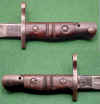
Click on the thumbnail for the full size photo.
A Remington Model 1917 Bayonet With a 1918 Date Marking
Some otherwise standard Remington manufactured bayonets can be found dated 1918 instead of 1917. It is surmised that Remington changed the marking die in early 1918 to reflect the date of manufacture, as was standard on the Model 1905 bayonet. Apparently they were fairly quickly ordered to return to the 1917 marking, as the 1918 mark is fairly uncommon. I asked Jerry Janzen several years ago if he had found anything in the Remington records to officially document this, and he stated that he had not. In his book on Remington bayonets, he shows and mentions the 1918 mark but does not state any details.
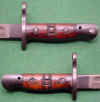
Click on the thumbnail for the full size photo.
A Winchester Model 1917 Bayonet With No Date or US Property Markings
This bayonet has always been a bit of a curiosity. It is other than the markings a typical 1917-1918 production Model 1917 bayonet, and has been sometimes called a pre-production model. This is very unlikely as Winchester had been producing the Pattern 1913 for the British and had no reason to manufacture any "prototype" versions. Although I am not aware of any written evidence, there seems to be a general feeling that these are "overruns" from military production. They were later sold with the commercial shotguns fitted with hand guard and stud for bayonet (the military style "trench guns") that were sold to police departments in the 20s and 30s. There are several advertisements from that time period that do show the shotgun being sold with the Model 1917 bayonet. If anyone has any solid evidence to the contrary, I would appreciate hearing about it.

Click on the thumbnail for the full size photo.
Detail of the Tang and Pommel Area
As described above from the manual, the guard and pommel were brazed to the tang. In the photo, the residue from the brazing can be clearly seen around the guard. The numbers on the tang are believed to be a steel lot number for quality control and heat treatment.
Following World War One and again after World War Two, many thousands of the Model 1917 bayonets were cleaned and refinished when necessary. The earlier refinish was a fairly dark and smooth Parkerizing, while later versions tend to be lighter in color and somewhat more granular. As the work could have been done in a number of countries that used this bayonet, the finish will vary and probably cannot normally be connected to a specific country. Among those countries that used the Model 1917, two are known to have marked them - Canada and Denmark. Both are marked on the side of the pommel with Canada using a Broad Arrow inside of a C, and Denmark the Crown over FTK mark. Other countries may have marked bayonets that have not yet come to my attention, and readers are invited to contact me with information along that line. Also, I am seeking decent specimens of the Canadian and Danish marked ones to add to my reference collection, and if any of you have one that you could spare for a reasonable price, please let me know.

Click on the thumbnail for the full size photo.
M1917 Bayonets
Above - Canadian Arsenals Ltd.
Below - General Cutlery
In the 1960s, due to the demand for a bayonet to fit the "trench" shotguns, two contractors again produced the Model 1917 bayonet (now officially designated the M1917). The contracts were issued to General Cutlery of Fremont, Ohio and Canadian Arsenals Ltd., the old Long Branch Arsenal of Quebec, Canada. To date, I have not been able to find contract dates and quantities, although one package label from a General Cutlery bayonet has a contract date of 1969. At one time both of these were quite uncommon, but some have been sold into surplus in recent years and although they are still not common, they can be found with some regularity. The Canadian Arsenals specimens seem to be less common than those made by General Cutlery.
The fit and finish of the 1960s production is not up to the standard of the 1917-18 period, but the usefulness of the bayonet is probably not impaired. The grips are a sharply diamond checkered black plastic, and the finish is a medium to dark gray fairly smooth Parkerizing. The guard is held to the blade by two roll pins rather than being brazed on as was the earlier production. The pommel is brazed to the tang. The catch thumb piece is held to the catch by a transverse roll pin instead of being screwed on as was the case in the WW1 production.
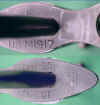
Click on the thumbnail for the full size photo.
Maker Marks on the Guards of the M1917 Bayonets
Above - Canadian Arsenals Ltd.
Below - General Cutlery
In the photo above, it should be noted that the Defense Acceptance Stamp (DAS) mark is stamped into the guard of the General Cutlery specimen, while the Canadian Arsenals version uses a white painted DAS.
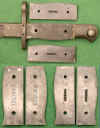
Click on the thumbnail for the full size photo.
M1917 Bayonets - Grips and Tang Area
Above is the General Cutlery version with the grips removed. The residue of the brazing process can be seen at the edge of the pommel/tang joint, and the roll pins holding the guard to the tang can clearly be seen. Below are the grips from each maker, with the Canadian Arsenal Ltd. on the left and the General Cutlery on the right. Both are marked with the part number, but there is a significant difference in the size of the marking.
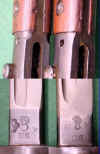
Click on the thumbnail for the full size photo.
Differences Between Remington and Winchester Production
There are several small differences between the Remington and Winchester produced bayonets, and I thought I would show them, as there have been a few cases where someone has tried to change a Remington into a more desirable (and expensive) Winchester. In fact, not too long ago, Frank was kind enough to show me a photo of a 1918 dated Remington that someone had removed the Remington marking inside the circle and stamped a W in its place. Fortunately close examination showed what had been done, so the ultra-rare 1918-dated Winchester was recognized as a fake and returned.
To prevent similar problems, I have attempted to illustrate some of the differences in the photo above - the Remington is on the left and the Winchester on the right.
- The shape of the cut on the top of the pommel where it blends into the grips. Remington used a rounded cut while Winchester used a simple triangular taper cut. I am told that early Remington M1913s made for the British used a cut similar to Winchester, but it appears that they had adopted the rounded cut by the time US production began.
- Note in the lower photo the shape of the fuller as it blends into the ricasso. Also the difference in the way the true edge blends into the ricasso - although this will vary quite a bit from specimen to specimen and is not as consistent as the fuller end Close examination will show that the fuller itself is cut somewhat differently but is hard to show in a photo.
- The shape of the flames of the Ordnance Shell and Flame is somewhat different. Winchester used a semicircle inside the shell, which is sometimes called the "smiley face" Shell and Flame.
- There is considerable difference in the eagle over number Inspector mark, and this is fairly consistent throughout production. Remington used a large eagle deeply stamped, and Winchester a much smaller eagle and lightly stamped.
These characteristics make it very easy to tell the maker without depending on the maker stamp.